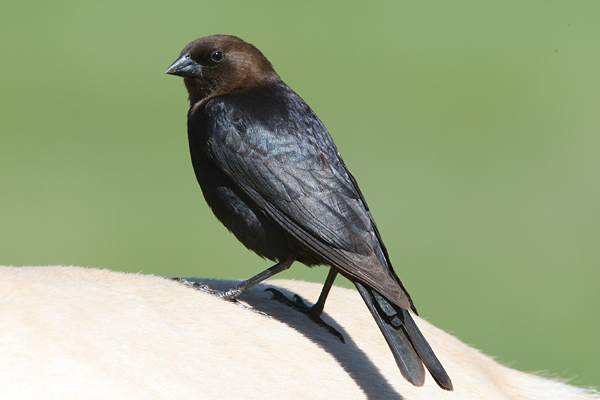|
Utah Bird Profile |
|||||
|
Name Roots: (Gr. molothrus, from molobros, "a parasite or greedy person" - L. ater, "black") |
|||||
| In Utah: |
 by Jack Binch |
||||
Nesting,
|
Nests in a tree or in a shrub or in a ground at a height of feet, in a
parasite nest. This species is not a cowbird host. During the breeding
season, this species is an omnivore: ground forager. During the
non-breeding seasons this species is a granivore:
ground gleaner. The cowbird is listed as a common summer resident and a rare winter resident. Cowbirds are widely distributed throughout the state. In fact, this species is now sufficiently numerous to pose a major threat to the survival of several species due to its successful habit of parasitizing their nests. |
||||
|
(Continued) |
Quoting from pages 619 and 621 of The Birder's Handbook, a
Field Guide to The Natural History of North American Birds, by Paul R.
Ehrlich, et. al.: “The Brown-headed Cowbird now has been recorded as
successfully parasitizing 144 of 220 species in whose nests its eggs have
been observed.” Songbirds especially targeted are flycatchers, warblers,
finches and vireos. “Each female's laying cycle appears adapted to take
advantage of a continuous supply of host nests for about a two-month period.
An average female lays about 80 eggs, 40 per year for two years...A female
Brown-headed Cowbird often locates a potential host nest during its
construction. She then regularly visits the nest prior to laying while the
owners are absent. One day prior to, or on the day she lays her egg, the
female cowbird usually removes (and occasionally eats) one host egg from the
nest. This cowbird is the only wild passerine ever reported not to show
regression of ovaries and oviducts following clutch completion” which “leads ornithologists
to characterize female cowbirds as `"passerine chickens!'” ~
Merrill Webb |
||||
| Habitat: | Breeds in Utah in agriculture
and urban habitats. |
||||
| How to find: |
Cowbirds can be observed during the breeding season
in “open areas with scattered trees, cultivated areas, pastures, riparian
thickets, swamps, and around human habitation.”
~ Merrill Webb |
||||
|
|
USGS Profile
|
US
Winter Range Map |
US
Summer Range Map |
Article
"From Buffalo Birds ..." | |
|||||
|
|||||
|
Abbreviations | References | Legend
|
|||||